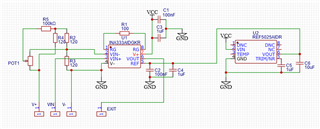Other Parts Discussed in Thread: LM4120, INA848, INA818, ADS1115
Hi team!
I'm working on an amplifier for strain gauges, it will work with 120ohm strain gauges @5V. Based on this circuit, an ina333 is used to amplify the unbalanced signal of the bridge. It is added 2.5V offset to allow signals belonging from both sides unbalancing. All resistors are 0.05% and 10ppm/°C, because the amplifier needs to work with minimum drift between 20 and 60 °C.
As thread title, my doubts are about bridge excitation: I would like to use 5V precise reference, but I think 50mA are too much to any voltage reference. What can I choose insted?
I know should be better to not zeroing bridge, but INA333 have only +- 0.3 V of differential input, and can be saturated by only initial unbalancing of the bridge. I think the potentiometer in this configuration will drift the same on both sides, leading to common-mode offset will not change the output of INA333.


